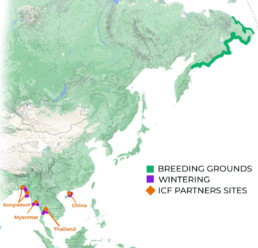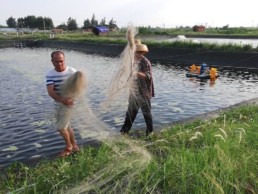Location
Sandwip Island and Sonadia Island in Bay of Bengal, Bangladesh; Nan Thar Island, in Rakhine state, Myanmar; Leizhou, Guandong province, China; and Pak Thale, Thailand.
Goal
Reduce the impacts of hunting (netting and nooses) on the Spoon-billed Sandpiper to stop and reverse their dramatic population decline.
Project Field Partner
Project field coordinator Sayam U. Chowdhury, Assistant Coordinator of the Spoon-billed Sandpiper Recovery Task Force, works with several partner organizations in Bangladesh, Myanmar, Thailand and China.
Maps data © 2024 Google

Race Against Extinction
The Critically Endangered Spoon-billed Sandpiper, which breeds in Russia and winters in Southeast Asia, is one of the world’s most threatened shorebirds, with only 100 known breeding pairs. Conservation efforts underway, including this project, give hope for the species. Intertidal mudflats along the East Asian-Australasian Flyway support more than 50 million migratory birds each year, including 33 globally threatened species, hence efforts for this species provide broader benefits. At present, 80 percent of the known population of the Spoon-billed Sandpiper winters in Myanmar, Bangladesh, China, and Thailand.
Threats:
Throughout its migratory range, invertebrate-rich tidal flats are being converted to industrial use and adult birds are being hunted for food. There are no known immediate threats on its breeding grounds, but sea level rise and other effects of climate change are likely to be an impact throughout its range. Many other shorebird species occupying these same habitats face the same threats and will also benefit from this project.
Critically Endangered
Only 100 known breeding pairs remaining
United Front to Safeguard Spoon-Billed Sandpipers
The project for the Spoon-billed Sandpiper (CR) continues in shorebird landscapes across four countries in Asia, with a total count of 43 spoon-billed Sandpipers (along with 67,555 waterbirds of 65 species). These areas also supported 300 globally endangered Nordmann’s Greenshanks (EN), 7,159 Great Knots, and other threatened shorebirds. In addition to site protection, along stretches of coast we have removed hundreds of illegal mist nets (which are used to trap birds) and carried out effective conservation outreach work in communities throughout the Spoon-billed Sandpiper winter range.
Specific actions include:
- guarding sites to protect birds from hunting
- developing livelihoods in farming and fishing as an alternative to hunting
- establishing no-hunting bylaws among Village Conservation Groups
- supporting local non-governmental organizations to increase awareness of hunting’s impact on this endangered bird.

Mistnet removal at South China. photo: hkbws

